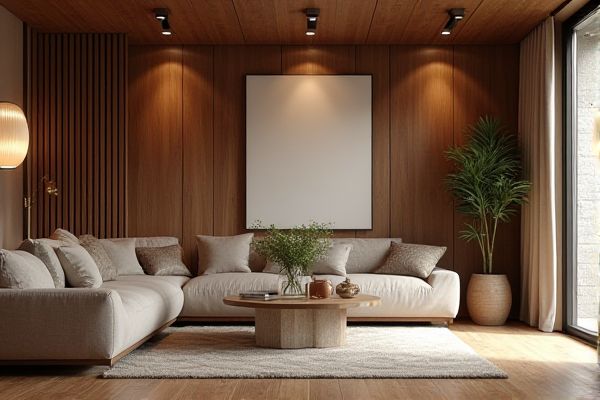
Walnut wood boasts a rich, dark hue and smooth grain, making it ideal for elegant furniture and decorative accents, while oak wood is prized for its strength, durability, and prominent grain patterns, perfect for heavy-use items and traditional designs. Discover how these differences can influence your choice by reading the rest of the article.
Table of Comparison
| Feature | Walnut Wood | Oak Wood |
|---|---|---|
| Appearance | Rich dark brown with purple undertones | Light to medium brown with prominent grain |
| Durability | High, moderately resistant to wear and decay | Very high, strong and highly resistant to wear |
| Hardness (Janka Rating) | 1,010 lbf | 1,290 lbf (Red), 1,360 lbf (White) |
| Grain Pattern | Fine, straight to wavy grain | Coarse, open grain with prominent rays |
| Workability | Easy to work with hand and power tools | Moderate; can be tough on tools due to hardness |
| Common Uses | Furniture, cabinetry, gunstocks, veneers | Furniture, flooring, cabinetry, barrels |
| Cost | Higher-priced, premium hardwood | More affordable and widely available |
Overview of Walnut Wood vs Oak Wood
Walnut wood offers a rich, dark brown color with a fine, straight grain pattern, making it highly prized for luxury furniture and cabinetry due to its durability and smooth finish. Oak wood, known for its strength and prominent grain, features a lighter color range from light tan to medium brown, often used in flooring, cabinetry, and sturdy furniture because of its hardness and resistance to wear. Your choice between walnut and oak will depend on the desired aesthetic, durability needs, and budget, with walnut typically being more expensive and oak favored for its robustness and classic appeal.
Appearance and Color Differences
Walnut wood features rich, deep brown tones often with purplish or chocolate hues, offering a striking contrast to oak's lighter, golden to medium brown shades with prominent grain patterns. Oak wood typically displays a more pronounced texture with visible rays and knots, while walnut offers a smoother, more uniform grain with occasional swirls. Your choice between walnut and oak will impact the visual warmth and sophistication of your furniture or flooring.
Grain Patterns and Texture
Walnut wood features a straight grain with occasional waves and a fine to medium texture, providing a smooth, luxurious finish ideal for furniture and cabinetry. Oak wood displays a prominent, open grain pattern with a coarse texture, characterized by distinctive rays and flecks that add rustic charm and durability. The fine, consistent grain of walnut contrasts with oak's bold, varied texture, influencing their aesthetic and tactile appeal in woodworking.
Durability and Hardness Comparison
Walnut wood offers moderate durability with a Janka hardness rating of about 1,010, making it suitable for furniture and interior uses that require some wear resistance. Oak wood, especially white oak, boasts higher durability, with a Janka hardness of around 1,360, providing greater resistance to dents and scratches ideal for heavy-use flooring and cabinetry. Your choice between walnut and oak should consider oak's superior hardness for long-lasting structural applications and walnut's balanced durability for elegant but sturdy finishes.
Workability and Ease of Finishing
Walnut wood offers excellent workability with a smooth grain that sands and finishes uniformly, making it ideal for detailed woodworking projects. Oak wood, while harder and more porous, requires more effort to sand and finish but provides a durable surface that takes stain well, enhancing your furniture's robustness. Choosing walnut can simplify your finishing process, but oak's strength benefits long-lasting applications.
Cost and Availability
Walnut wood generally commands a higher price than oak due to its rich color, grain pattern, and limited availability. Oak is more abundant and widely harvested, making it a more cost-effective option for furniture and flooring projects. Your choice may depend on budget constraints and the desired aesthetic quality, with oak providing affordability and walnut offering exclusivity.
Common Uses in Furniture and Flooring
Walnut wood is prized for high-end furniture, cabinetry, and decorative veneers due to its rich color and fine grain. Oak wood is commonly used in flooring, cabinetry, and traditional furniture because of its durability and distinctive grain patterns. Your choice between walnut and oak wood will impact the style and longevity of furniture or flooring in your space.
Maintenance and Longevity
Walnut wood requires moderate maintenance due to its softer nature compared to oak, necessitating regular cleaning and occasional refinishing to prevent scratches and wear. Oak wood is highly durable with excellent resistance to dents and moisture, making it a long-lasting option that demands less frequent upkeep. Both woods benefit from proper sealing and conditioning, but oak typically offers superior longevity in high-traffic environments.
Environmental Impact and Sustainability
Walnut wood is generally considered less sustainable than oak due to its slower growth rate and higher demand, which can lead to increased deforestation and habitat loss. Oak wood, particularly from responsibly managed forests, offers a more environmentally friendly option because it grows faster and is often sourced from certified sustainable forests, reducing the carbon footprint. When choosing your wood, prioritizing certified oak can contribute to better forest conservation and reduced environmental impact.
Which Wood is Best for Your Project?
Walnut wood offers rich color, fine grain, and durability, making it ideal for high-end furniture and decorative pieces, while oak wood provides exceptional strength, wear resistance, and a prominent grain pattern suited for flooring and heavy-use furniture. Choosing between walnut and oak depends on your project's aesthetic and functional requirements, with walnut favored for elegant, darker finishes and oak preferred for rustic or traditional styles requiring long-lasting performance. Both hardwoods are versatile, but understanding their distinct properties ensures selecting the best wood to meet your design and durability needs.
 homyna.com
homyna.com